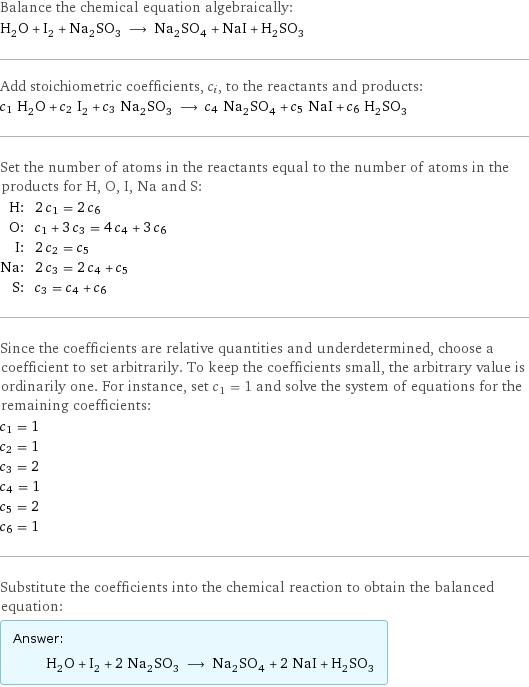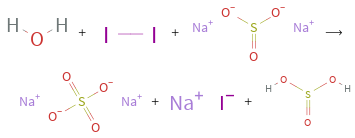Input interpretation

H_2O water + I_2 iodine + Na_2SO_3 sodium sulfite ⟶ Na_2SO_4 sodium sulfate + NaI sodium iodide + H_2SO_3 sulfurous acid
Balanced equation

Balance the chemical equation algebraically: H_2O + I_2 + Na_2SO_3 ⟶ Na_2SO_4 + NaI + H_2SO_3 Add stoichiometric coefficients, c_i, to the reactants and products: c_1 H_2O + c_2 I_2 + c_3 Na_2SO_3 ⟶ c_4 Na_2SO_4 + c_5 NaI + c_6 H_2SO_3 Set the number of atoms in the reactants equal to the number of atoms in the products for H, O, I, Na and S: H: | 2 c_1 = 2 c_6 O: | c_1 + 3 c_3 = 4 c_4 + 3 c_6 I: | 2 c_2 = c_5 Na: | 2 c_3 = 2 c_4 + c_5 S: | c_3 = c_4 + c_6 Since the coefficients are relative quantities and underdetermined, choose a coefficient to set arbitrarily. To keep the coefficients small, the arbitrary value is ordinarily one. For instance, set c_1 = 1 and solve the system of equations for the remaining coefficients: c_1 = 1 c_2 = 1 c_3 = 2 c_4 = 1 c_5 = 2 c_6 = 1 Substitute the coefficients into the chemical reaction to obtain the balanced equation: Answer: | | H_2O + I_2 + 2 Na_2SO_3 ⟶ Na_2SO_4 + 2 NaI + H_2SO_3
Structures

+ + ⟶ + +
Names

water + iodine + sodium sulfite ⟶ sodium sulfate + sodium iodide + sulfurous acid
Equilibrium constant
![Construct the equilibrium constant, K, expression for: H_2O + I_2 + Na_2SO_3 ⟶ Na_2SO_4 + NaI + H_2SO_3 Plan: • Balance the chemical equation. • Determine the stoichiometric numbers. • Assemble the activity expression for each chemical species. • Use the activity expressions to build the equilibrium constant expression. Write the balanced chemical equation: H_2O + I_2 + 2 Na_2SO_3 ⟶ Na_2SO_4 + 2 NaI + H_2SO_3 Assign stoichiometric numbers, ν_i, using the stoichiometric coefficients, c_i, from the balanced chemical equation in the following manner: ν_i = -c_i for reactants and ν_i = c_i for products: chemical species | c_i | ν_i H_2O | 1 | -1 I_2 | 1 | -1 Na_2SO_3 | 2 | -2 Na_2SO_4 | 1 | 1 NaI | 2 | 2 H_2SO_3 | 1 | 1 Assemble the activity expressions accounting for the state of matter and ν_i: chemical species | c_i | ν_i | activity expression H_2O | 1 | -1 | ([H2O])^(-1) I_2 | 1 | -1 | ([I2])^(-1) Na_2SO_3 | 2 | -2 | ([Na2SO3])^(-2) Na_2SO_4 | 1 | 1 | [Na2SO4] NaI | 2 | 2 | ([NaI])^2 H_2SO_3 | 1 | 1 | [H2SO3] The equilibrium constant symbol in the concentration basis is: K_c Mulitply the activity expressions to arrive at the K_c expression: Answer: | | K_c = ([H2O])^(-1) ([I2])^(-1) ([Na2SO3])^(-2) [Na2SO4] ([NaI])^2 [H2SO3] = ([Na2SO4] ([NaI])^2 [H2SO3])/([H2O] [I2] ([Na2SO3])^2)](../image_source/07054631f500f47b1f3fd506f224a2c2.png)
Construct the equilibrium constant, K, expression for: H_2O + I_2 + Na_2SO_3 ⟶ Na_2SO_4 + NaI + H_2SO_3 Plan: • Balance the chemical equation. • Determine the stoichiometric numbers. • Assemble the activity expression for each chemical species. • Use the activity expressions to build the equilibrium constant expression. Write the balanced chemical equation: H_2O + I_2 + 2 Na_2SO_3 ⟶ Na_2SO_4 + 2 NaI + H_2SO_3 Assign stoichiometric numbers, ν_i, using the stoichiometric coefficients, c_i, from the balanced chemical equation in the following manner: ν_i = -c_i for reactants and ν_i = c_i for products: chemical species | c_i | ν_i H_2O | 1 | -1 I_2 | 1 | -1 Na_2SO_3 | 2 | -2 Na_2SO_4 | 1 | 1 NaI | 2 | 2 H_2SO_3 | 1 | 1 Assemble the activity expressions accounting for the state of matter and ν_i: chemical species | c_i | ν_i | activity expression H_2O | 1 | -1 | ([H2O])^(-1) I_2 | 1 | -1 | ([I2])^(-1) Na_2SO_3 | 2 | -2 | ([Na2SO3])^(-2) Na_2SO_4 | 1 | 1 | [Na2SO4] NaI | 2 | 2 | ([NaI])^2 H_2SO_3 | 1 | 1 | [H2SO3] The equilibrium constant symbol in the concentration basis is: K_c Mulitply the activity expressions to arrive at the K_c expression: Answer: | | K_c = ([H2O])^(-1) ([I2])^(-1) ([Na2SO3])^(-2) [Na2SO4] ([NaI])^2 [H2SO3] = ([Na2SO4] ([NaI])^2 [H2SO3])/([H2O] [I2] ([Na2SO3])^2)
Rate of reaction
![Construct the rate of reaction expression for: H_2O + I_2 + Na_2SO_3 ⟶ Na_2SO_4 + NaI + H_2SO_3 Plan: • Balance the chemical equation. • Determine the stoichiometric numbers. • Assemble the rate term for each chemical species. • Write the rate of reaction expression. Write the balanced chemical equation: H_2O + I_2 + 2 Na_2SO_3 ⟶ Na_2SO_4 + 2 NaI + H_2SO_3 Assign stoichiometric numbers, ν_i, using the stoichiometric coefficients, c_i, from the balanced chemical equation in the following manner: ν_i = -c_i for reactants and ν_i = c_i for products: chemical species | c_i | ν_i H_2O | 1 | -1 I_2 | 1 | -1 Na_2SO_3 | 2 | -2 Na_2SO_4 | 1 | 1 NaI | 2 | 2 H_2SO_3 | 1 | 1 The rate term for each chemical species, B_i, is 1/ν_i(Δ[B_i])/(Δt) where [B_i] is the amount concentration and t is time: chemical species | c_i | ν_i | rate term H_2O | 1 | -1 | -(Δ[H2O])/(Δt) I_2 | 1 | -1 | -(Δ[I2])/(Δt) Na_2SO_3 | 2 | -2 | -1/2 (Δ[Na2SO3])/(Δt) Na_2SO_4 | 1 | 1 | (Δ[Na2SO4])/(Δt) NaI | 2 | 2 | 1/2 (Δ[NaI])/(Δt) H_2SO_3 | 1 | 1 | (Δ[H2SO3])/(Δt) (for infinitesimal rate of change, replace Δ with d) Set the rate terms equal to each other to arrive at the rate expression: Answer: | | rate = -(Δ[H2O])/(Δt) = -(Δ[I2])/(Δt) = -1/2 (Δ[Na2SO3])/(Δt) = (Δ[Na2SO4])/(Δt) = 1/2 (Δ[NaI])/(Δt) = (Δ[H2SO3])/(Δt) (assuming constant volume and no accumulation of intermediates or side products)](../image_source/d009f5134e49a6a9fd9a47e5143ef3ce.png)
Construct the rate of reaction expression for: H_2O + I_2 + Na_2SO_3 ⟶ Na_2SO_4 + NaI + H_2SO_3 Plan: • Balance the chemical equation. • Determine the stoichiometric numbers. • Assemble the rate term for each chemical species. • Write the rate of reaction expression. Write the balanced chemical equation: H_2O + I_2 + 2 Na_2SO_3 ⟶ Na_2SO_4 + 2 NaI + H_2SO_3 Assign stoichiometric numbers, ν_i, using the stoichiometric coefficients, c_i, from the balanced chemical equation in the following manner: ν_i = -c_i for reactants and ν_i = c_i for products: chemical species | c_i | ν_i H_2O | 1 | -1 I_2 | 1 | -1 Na_2SO_3 | 2 | -2 Na_2SO_4 | 1 | 1 NaI | 2 | 2 H_2SO_3 | 1 | 1 The rate term for each chemical species, B_i, is 1/ν_i(Δ[B_i])/(Δt) where [B_i] is the amount concentration and t is time: chemical species | c_i | ν_i | rate term H_2O | 1 | -1 | -(Δ[H2O])/(Δt) I_2 | 1 | -1 | -(Δ[I2])/(Δt) Na_2SO_3 | 2 | -2 | -1/2 (Δ[Na2SO3])/(Δt) Na_2SO_4 | 1 | 1 | (Δ[Na2SO4])/(Δt) NaI | 2 | 2 | 1/2 (Δ[NaI])/(Δt) H_2SO_3 | 1 | 1 | (Δ[H2SO3])/(Δt) (for infinitesimal rate of change, replace Δ with d) Set the rate terms equal to each other to arrive at the rate expression: Answer: | | rate = -(Δ[H2O])/(Δt) = -(Δ[I2])/(Δt) = -1/2 (Δ[Na2SO3])/(Δt) = (Δ[Na2SO4])/(Δt) = 1/2 (Δ[NaI])/(Δt) = (Δ[H2SO3])/(Δt) (assuming constant volume and no accumulation of intermediates or side products)
Chemical names and formulas

| water | iodine | sodium sulfite | sodium sulfate | sodium iodide | sulfurous acid formula | H_2O | I_2 | Na_2SO_3 | Na_2SO_4 | NaI | H_2SO_3 Hill formula | H_2O | I_2 | Na_2O_3S | Na_2O_4S | INa | H_2O_3S name | water | iodine | sodium sulfite | sodium sulfate | sodium iodide | sulfurous acid IUPAC name | water | molecular iodine | disodium sulfite | disodium sulfate | sodium iodide | sulfurous acid
Substance properties

| water | iodine | sodium sulfite | sodium sulfate | sodium iodide | sulfurous acid molar mass | 18.015 g/mol | 253.80894 g/mol | 126.04 g/mol | 142.04 g/mol | 149.89424 g/mol | 82.07 g/mol phase | liquid (at STP) | solid (at STP) | solid (at STP) | solid (at STP) | solid (at STP) | melting point | 0 °C | 113 °C | 500 °C | 884 °C | 661 °C | boiling point | 99.9839 °C | 184 °C | | 1429 °C | 1300 °C | density | 1 g/cm^3 | 4.94 g/cm^3 | 2.63 g/cm^3 | 2.68 g/cm^3 | 3.67 g/cm^3 | 1.03 g/cm^3 solubility in water | | | | soluble | | very soluble surface tension | 0.0728 N/m | | | | | dynamic viscosity | 8.9×10^-4 Pa s (at 25 °C) | 0.00227 Pa s (at 116 °C) | | | 0.0010446 Pa s (at 691 °C) | odor | odorless | | | | |
Units
